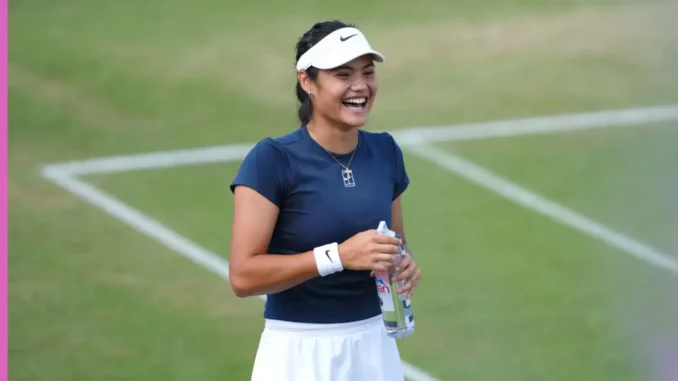
In the high-stakes ballet of professional tennis, where every slide on the baseline can pivot a career, Emma Raducanu has been scripting a comeback tale that’s equal parts grit and grace. At just 22, the British prodigy—whose name became synonymous with fairy-tale triumph when she stormed to the 2021 US Open title as a qualifier—has clawed her way back from the brink. Injuries, surgeries on wrists and ankles, and the relentless pressure of prodigy status once plunged her outside the top 300. But as the 2025 season hurtles toward its finale, Raducanu stands tall at No. 32 in the WTA rankings, a milestone that feels like sweet vindication. It’s not just a number; it’s the fulfillment of a deeply personal goal she set for herself: cracking the top 32 to secure seeding at the Australian Open and beyond, shielding her from the early-round minefields that have derailed too many dream runs.
Picture the scene in Beijing at the China Open, where the humid air hung heavy and the hard courts gleamed under floodlights. Raducanu, seeded 30th, faced Jaqueline Cristian in a second-round thriller that tested her mettle. The Romanian qualifier pushed her to the brink, forcing Raducanu into a grueling three-setter. But in the dying moments of the decider, with the match teetering, Raducanu unleashed a forehand winner that sealed a 6-4, 4-6, 6-3 victory. She collapsed to her knees, tears streaming down her face—not from exhaustion, but from the raw release of a breakthrough long overdue. “It means everything,” she later shared, her voice cracking with emotion. “I’ve worked so hard for this, through the pain and the doubts. To hit this target… it’s just the start.” That win, coupled with her straight-sets dispatch of Cristina Bucsa in the opener, propelled her into the top 32 for the first time since 2022, edging out her nearest challengers on the live rankings ladder.
Raducanu’s 2025 odyssey has been a masterclass in calculated resurgence. She kicked off the year with a third-round showing at the Australian Open, her best result there yet, before navigating a choppy spring marred by a back tweak that sidelined her from Auckland. Clay proved a mixed bag—four straight wins in Miami’s steamy quarterfinal run marked her deepest WTA 1000 penetration on the surface, but a first-round stumble in Madrid reminded her of its unforgiving bounce. Transitioning to grass, she channeled her inner warrior at Queen’s Club, battling illness to snag a quarterfinal berth and her first top-10 scalp over Jessica Pegula. Wimbledon followed suit with a fourth-round exit, but not before she toppled No. 9 Maria Sakkari in a match that echoed her Flushing Meadows magic.
The North American hard-court swing was where the sparks truly flew. In Washington DC, Raducanu surged to the semifinals, felling Elena-Gabriela Ruse and No. 32 Peyton Stearns before Amanda Anisimova halted her charge. Montreal brought another round-of-16 finish, and whispers of a US Open seed began to swirl. At Flushing Meadows, she defended minimal points from her 2021 heroics but added fresh momentum with a polished first-round win, climbing to No. 33 live. “I’ve earned 1,245 ranking points already this year—more than my full 2024 haul,” she noted post-match, a statistic that underscores her leap from 231 points in 2023. Her record stands at a robust 27-19, laced with upsets over Naomi Osaka and Victoria Azarenova, and a career-best $1.36 million in prize money.
This ascent isn’t solitary. Since August, Spaniard Francisco Roig has sharpened her edges in the practice pen, while fitness guru Yutaka Nakamura—tuner of Sharapova and Osaka—has fortified her against the tour’s physical grind. Raducanu’s game has evolved too: her forehand, once a wildcard, now packs consistent venom, and her serve has climbed to 68% first-serve points won. Doubles forays with Elena Rybakina in Washington added tactical depth, though singles remains her North Star. Off-court, she’s leaned into resilience, withdrawing from the Billie Jean King Cup to chase Asian points—a move that sparked debate but paid dividends. “I had to prioritize my body and my goals,” she explained. “It’s tough saying no, but this is my career.”
As October dawns, Raducanu eyes the Wuhan Open and Pan Pacific in Tokyo, where 1,000-point hauls could vault her toward the top 25. Experts see the stars aligning: Tim Henman, the former British No. 1, calls top 30 “completely realistic” with injury-free play. “Physical resilience is key,” he emphasized. “Emma’s got the talent; now it’s about stringing it together.” Her WTA Finals dreams hinge on a late surge, but seeding at Melbourne Park—averting clashes with the Sabalenkas and Swiateks early—looms largest. A top-20 finish? Ambitious, yet within reach if she targets WTA 250s for steady points, as one analyst suggests. “Breaking top 32 is symbolic,” they noted. “But with consistency, top 20 beckons.”
Raducanu’s story resonates beyond the stats. From a Toronto-born teen with Romanian-Chinese roots to Britain’s beacon, she’s navigated stalking scares (a February 2025 Dubai incident led to a WTA ban) and endorsement flux (Vodafone’s April split over contract woes). Yet her poise endures, inspiring a generation. As she prepares for Beijing’s third round against Pegula—the American leading their head-to-head 2-1—Raducanu carries the weight of a nation’s hopes lightly. “I’m excited and itching for what’s next,” she said, eyes alight. In a sport of ephemeral highs, her 2025 arc proves that true champions don’t just win majors; they reclaim their fire, one ranked rung at a time. With the off-season beckoning, Emma Raducanu isn’t just achieving goals—she’s redefining them, poised for a 2026 that could eclipse even her wildest US Open dreams.
Leave a Reply